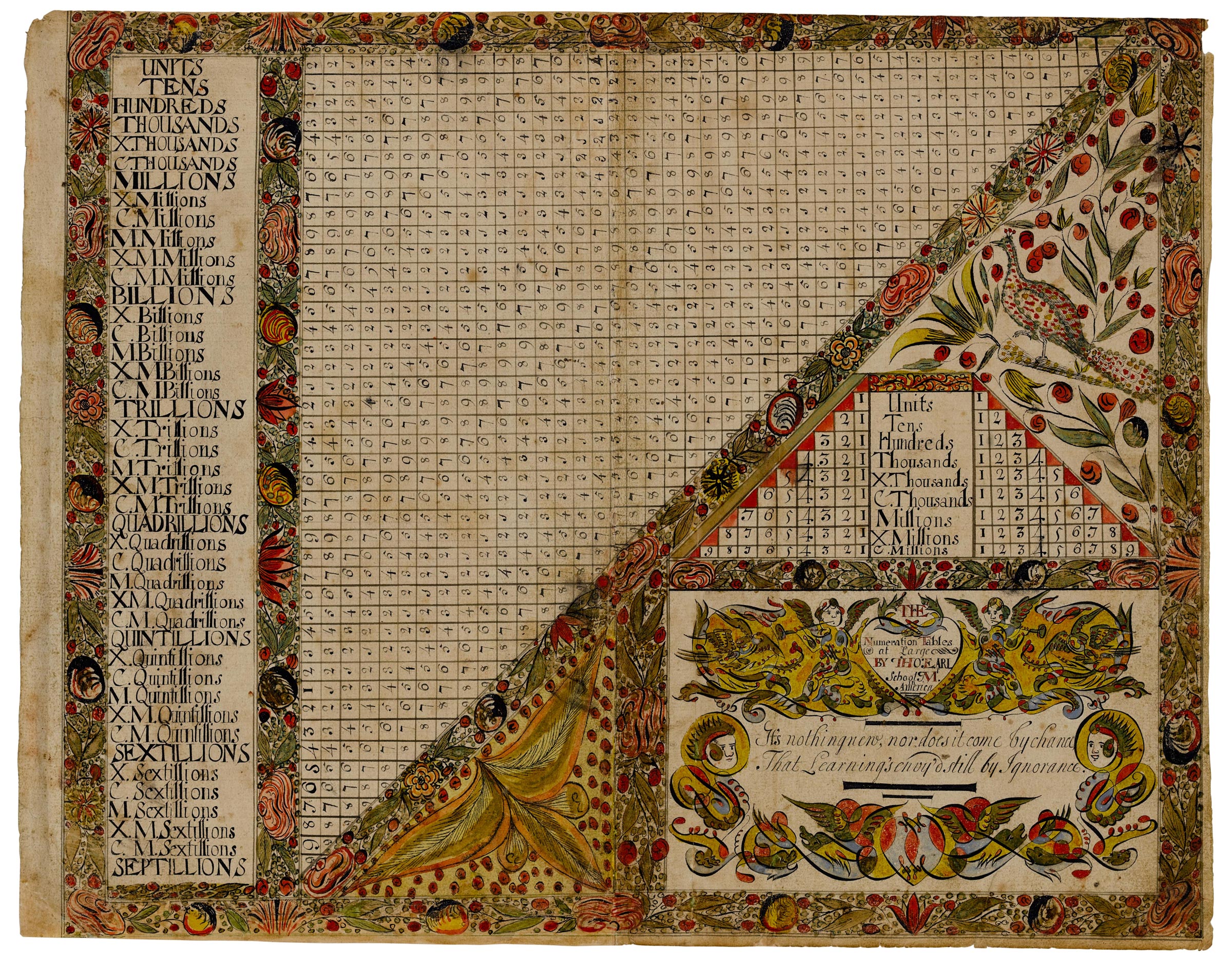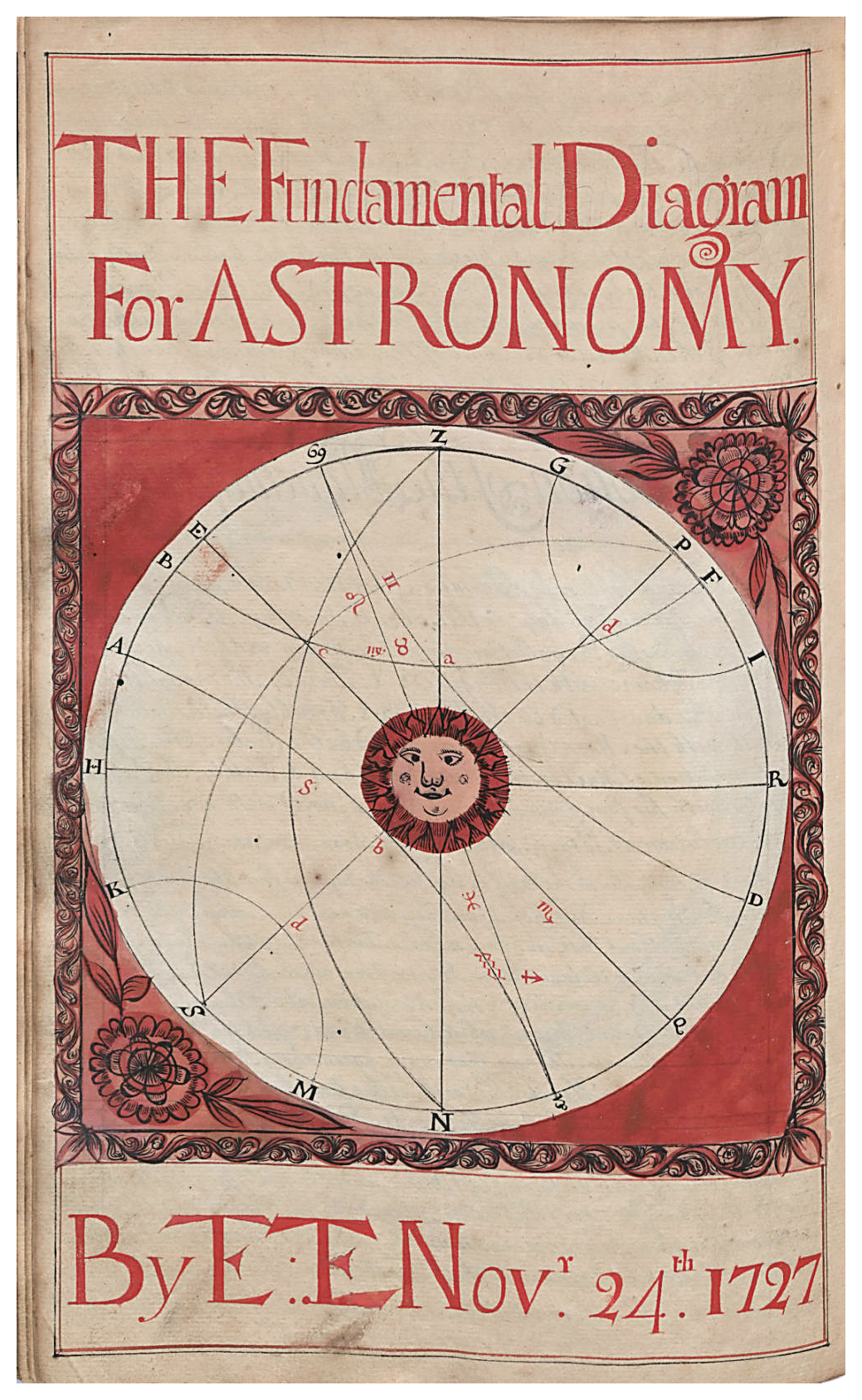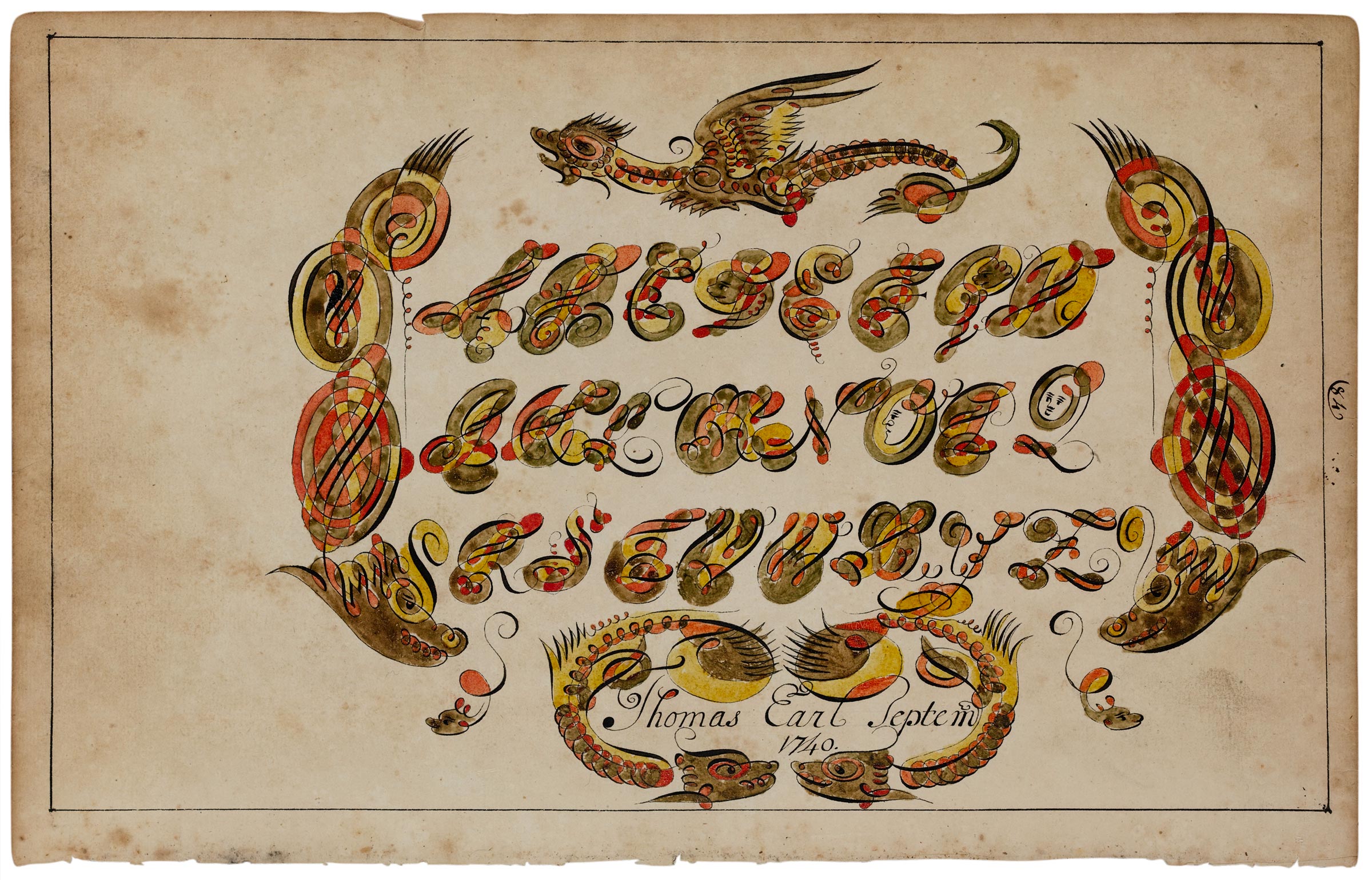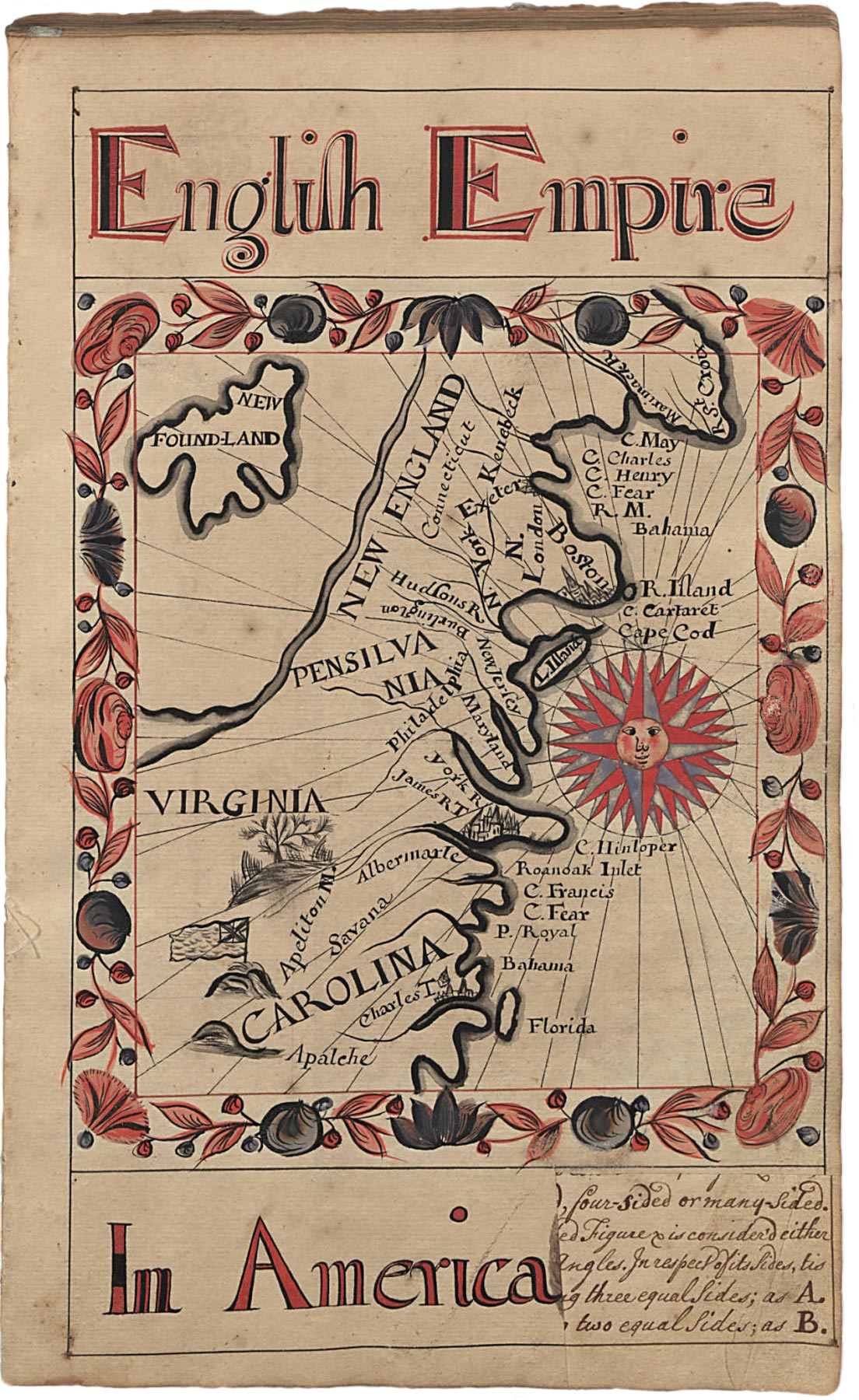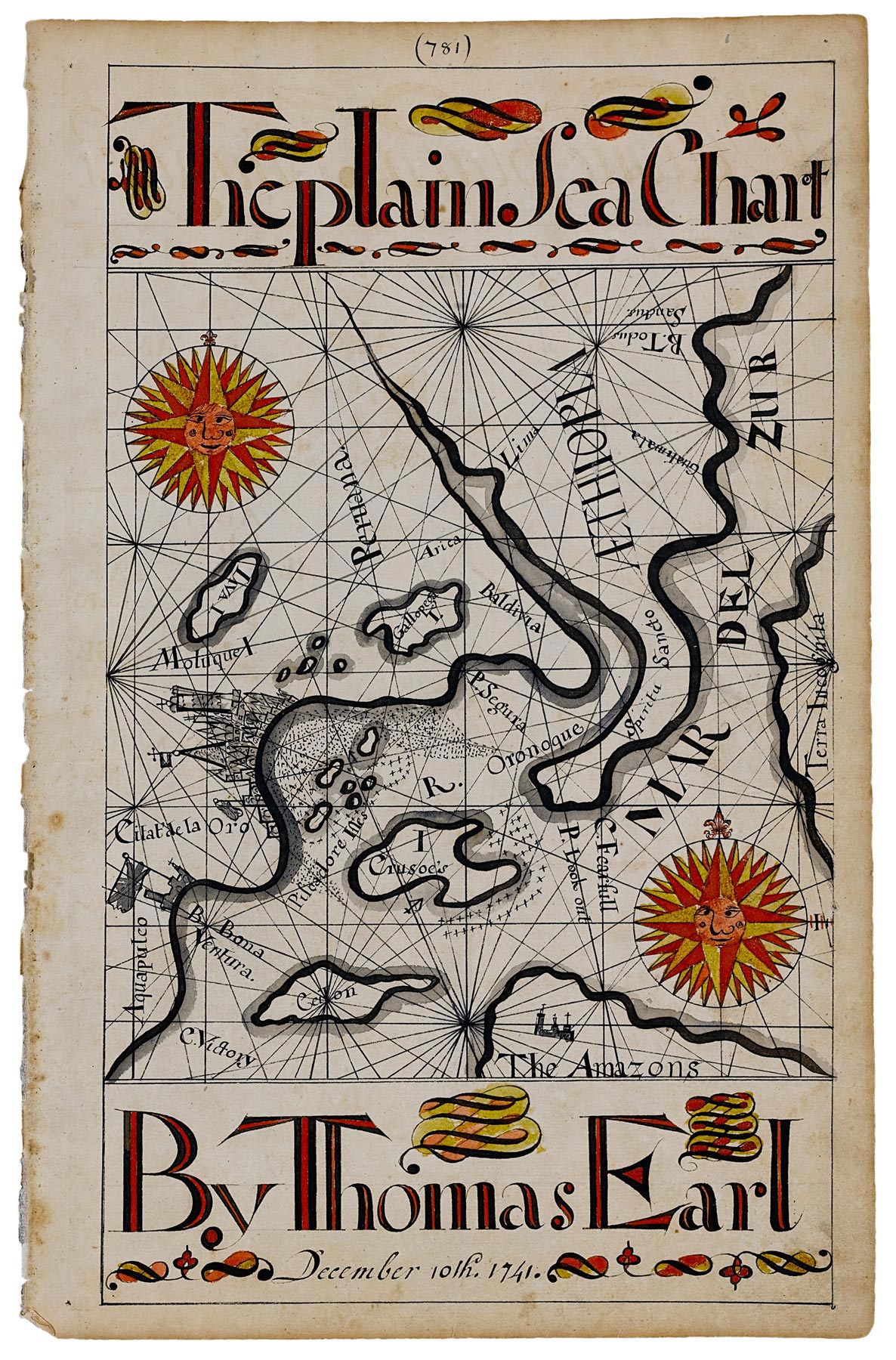Thomas Earl Part I:
Schoolmaster America
Editor’s Note
Deborah M. Child wrote three essays for Americana Insights about an early eighteenth-century New Jersey schoolmaster named Thomas Earl and the two copybooks known by his hand. While Earl had long been identified as a Rhode Island native who was born in Little Compton in 1704 and died in New Hanover, New Jersey, in 1751, Child has uncovered convincing evidence that earlier researchers mistakenly confused him with an unrelated namesake. The Thomas Earl who Child argues created the books was an English immigrant who was born near London in 1711 and came to America as an indentured servant in 1731.
Beyond a few bare facts, most of what is known about Earl can be gleaned from the two extant copybooks, also known as ciphering books, that he created in 1727 and 1740–41. In her first essay, Child introduces Earl and his copybooks, explaining what they are, what they consist of, and how they were found. Subsequent essays explore who Earl was and what is known about his life and work, his artistic sources and inspirations, and how his work fits into the context of early American education.
Thomas Earl’s two handwritten manuscripts are replete with lessons in arithmetic, geometry, trigonometry, navigation, and astronomy, which he enriched with calligraphic flourishes and stunning watercolor. The books not only served as essential teaching tools, but the second book in particular is tangible proof of his qualifications to teach. This was an occupation he clearly relished, as he signed the cartouche on one of its larger folio sheets “Tho. Earl School M[aster] America.” In the same manuscript, he proudly signed and/or dated another thirty-plus pages, from September 1740 to December 1741 (Figs. 1, 2).1
Rather than standing in front of a class and lecturing, colonial schoolmasters like Earl made their copybooks accessible for students to transcribe. Students would learn their lessons and, at the same time, create books of their own for future reference. This method of teaching was so widespread in America in the eighteenth and early nineteenth centuries that copybooks were the most common books found in households after the Bible and almanacs. Some even became family heirlooms. For example, Joseph Riley, a New Jersey resident, specified in his will of 1734 that “his great wrighting [sic] book and great arithematic book were to be given to his son Joseph.”2 It was not until the 1840s, when textbooks and other printed material became more readily available, that copybook usage declined.3 Today, they are appreciated mostly for what they reveal about how education has evolved in this country.
Earl’s earlier manuscript, which is dated 1727 and therefore created while he was a teenage student in England, contains no Greek or Latin, while his second manuscript, of 1740, has only a few lines in Latin, on pages 466 and 478. This near absence of classical languages reflects changes in the educational system in Britain and its colonies in the late seventeenth century in response to threats to its status as a world power, especially by the Dutch. Instead of providing instruction in these “dead languages,” as was done for those preparing for careers in law, medicine, and divinity, new curriculums were being developed to provide technical instruction in English to help students better prepare for careers in business, navigation, surveying, building, and engineering.4
One of the earliest surviving copybooks in colonial America reflecting an emphasis on practical education is the mathematical exercise book kept by New Jersey joiner Stacy Beakes (1706–c. 1745). Now in the archives of Princeton University, it contains 230 folio sheets and was executed when he was a fourteen-year-old student. The teacher who provided the lessons Beakes copied into his own book has not been identified, but the book’s elaborate title page design, executed in ink, reveals another creative hand at work. The accounting lessons it contains would later prove essential for Beakes when he acquired his own cabinetmaking shop in Trenton, New Jersey (Fig. 3).5
The emphasis on practical education, as demonstrated by the lessons in Earl’s copybooks, was similarly fostered by Quakers, many of whom settled the area of New Hanover, where Earl resided. Quakers in this area maintained a close-knit network of property owners and artisans throughout West Jersey, on the east side of the Delaware River, who had easy access to Pennsylvania, Maryland, Delaware, and New York. Given the lessons that Earl could impart, Quakers may well have engaged his services as a schoolmaster.
Aside from the sheer beauty of Earl’s copybooks and their superb state of preservation, what is most outstanding is the unusually broad range of subject matter he covered, including astronomy, alphabets, weights, measures, currencies, computation of interest and discounts, algebra, geometry, trigonometry, astronomy, cartography, navigation, tides and currents, calendars and dates, and games of math and puzzles (Fig. 4).


Earl’s 1727 copybook consists of 183 pages on paper bearing the watermark of King George II, who ruled Great Britain and Ireland from 1727 until his death in 1760. It measures 12 ⅜ by 7 ¾ inches and is bound in its original leather, inscribed on the front “TE’S Book.” The pages are not numbered, and snippets have been taken from some of them.6
The lessons contained within encompass a broad range of subject matter, from algebra to navigation and astronomy. Dates with the year 1727 appear in several of the word problems. Much of the text is written in calligraphy, with headings in a decorative scroll. Geometric figures are often included to illustrate how the calculations are derived. Six pages that prefigure Earl’s later book are enhanced with watercolor washes, including “The Fundamental Diagram for Astronomy,” which is signed T. E. and dated November 24, 1727 (Fig. 5).7
Sometime around 1980, Earl’s second copybook was purchased from descendants of the artist in Pennsylvania by Dr. James A. Piccolo of Orange, Connecticut. At that time, it lacked a cover and consisted of 640 loose pages, again bearing the watermark of King George II. Unlike his earlier manuscript, these pages were numbered up to page 910 and measured twelve by eight inches with an additional three folio sheets of Dutch-made paper measuring 12 ½ by 16 inches (Fig. 6).8
The coloring of this copybook is without precedent in this country at that early date and is also a testament to the care the Earl family had taken to preserve its contents. At the time of his purchase, Dr. Piccolo was told the artist made his own pigments. As there were few retailers of pigments in the colonies at the time, this assertion is probably accurate (Figs. 7, 8).9
Despite the thirteen-year gap between the two manuscripts, many pages from Earl’s second copybook repeat some of the same text and illustrations found in his 1727 work, with only minor variations. These include his folio sheets titled “English Empire,” “The Plain Sea Chart,” “The Ptolomaick System,” “The Copernican System,” and “The Tychonian System” (Figs. 9, 10, 11, 12).
Earl’s later copybook is far more elaborate and detailed than the first, complete with title pages and three larger folio sheets. The first 124 pages are devoted to exercises in calligraphy. These were probably undertaken so he could offer his services as a writing master as well as a tutor in mathematics and navigation. Other pages in this book are much more advanced in both content and complexity, especially in mathematics. As such, he probably commenced the creation of his copybook in 1740 so that he could instruct older students in a more structured setting, such as an academy or college.10
But who was this masterful artist and where did he obtain such high quality paper and pigments to work with? How did he find the time in 1740 and 1741 to add so many elaborate embellishments? These are just a few of the more pressing issues to be addressed in my next essay.
Acknowledgments
About the Author
1 Page 57 of the 1740–41 copybook, September 1740, private collection; Page 781 of the 1740–41 copybook, December 10, 1741, private collection.
2 Joseph Riley, will dated January 25, 1734, in Documents Relating to the Colonial History of New Jersey, vol. 30: Calendar of New Jersey Wills, Administrations, etc. vol. 2, 1730–1750, ed. A. Van Doren Honeyman (Newark: New Jersey Historical Society, 1918), 400.
3 See Nerida Ellerton and M. A. (Ken) Clements, Rewriting the History of School Mathematics in North America 1607–1861: The Central Role of Cyphering Books (London: Springer, 2012).
4 Ray Nash, Some Early American Writing Books and Masters (Hanover, NH: self-pub, 1943), 9.
5 Stacy Beakes, mathematical exercise book, 1720–22, Rare Books and Special Collections, C0199 no. 100q, Princeton University Library. For further information concerning Beakes, see Jackie Killian, “Town vs. Country,” Town & Country: Early New Jersey’s Carpenters and Joiners, online supplement to “United by Water: Cabinetmaking Traditions in the Delaware River Valley, 1670–1740” (master’s thesis, University of Delaware, 2015).
6 Thomas Earl, exercise book, 1727, Doc. 735, Winterthur Library, Winterthur, DE (hereafter cited as Winterthur). The book was given to the Winterthur Library in 1994 by Stanley P. Sax, a prominent Americana collector from Bloom- field Hills, Michigan. He had apparently purchased it from Alexander Acevedo, proprietor of the Alexander Gallery in New York City. When and where Acevedo acquired it is not known. Carley C. Altenburger, email message to author, November 4, 2020.
7 The other five folio sheets are “Mariner’s Compass” (image 5); “The English Empire” (image 11); “The Figure of the Nocturnal” (image 156); “The Ptolomaick System” (image 158); “The Copernican System” (image 159); and “The Tychonian System” (image 160), Winterthur.
8 In the January 1986 issue of The Magazine Antiques, fine arts dealer Rudolph G. Wunderlich advertised these pages for sale. Several institutions and private collectors were interested in individual pages, but Wunderlich was unable to sell the manuscript in its entirety. In 1998, about half of the 588 pages from Earl’s book that were considered of lesser quality were sold to the Newberry Library, an independent, noncirculating research library in Chicago. On August 12, 2001, one of the larger folio sheets (12 × 16 1⁄2 inches), titled “A Beautiful Countenance” and numbered page 55, was sold at the Americana auction at Skinner in Bolton, Massachusetts. A label on the reverse identified the work as being page 82 from “Practical Mathematics” [Earl’s handwritten book]. No details of provenance were given at the time of sale. In 2005, Rudolph Wunderlich’s widow, Susan Mongerson Wunderlich, donated another seven pages from the book to the Newberry. In 2007, the Newberry purchased page 124 from an undisclosed source. Special Collections, MS 105 (hereafter cited as Newberry).
In 2009, another fifty-eight pages, representing the aesthetic core of the manuscript, surfaced at a benefit appraisal day held for Connecticut Public Television. They were brought to the appraisal by two of Dr. Piccolo’s daughters, who commissioned Connecticut dealer and appraiser Allan Katz to try to sell them. Katz took the manuscript to the Philadelphia Antiques Show in April 2010, where he exhibited eighteen pages he had framed, with the remaining forty contained in two portfolios. Katz intended only to sell individual pages, but fellow Connecticut folk art dealer David A. Schorsch, whose mother, Marjorie, had tried to convince a prominent client to buy the entire manuscript from Wunderlich, remembered the work well and thought it should be kept together. After discussions with his business partner, Eileen M. Smiles, the pair approached a visionary client who agreed to acquire all the remaining pages of the work. Those pages still reside in that private collection today.
Pages that are still missing include the cover, pages 1–24, 44–48, 50–52, 96–98, 516–40, 668–92, 701–16, 730, 746–48, 751–52, 759–60, 782, 908, and possibly pages numbered higher than 910.
9 Small hard cakes of soluble watercolor did not become commercially available until William Reeves invented them in 1780.
10 Lessons featured here, such as “The Double Rule of Three” (page 196, Newberry), were geared for those seeking employment as an applied problem solver. For an in-depth analysis of an earlier cypher book created in England featuring similarly advanced mathematics, see Nerida F. Ellerton and M. A. (Ken) Clements, “Thomas Prust his Booke Amen 1702,” in Abraham Lincoln’s Cyphering Book and Ten other Extraordinary Cyphering Books (London: Springer, 2014), 23–48.

